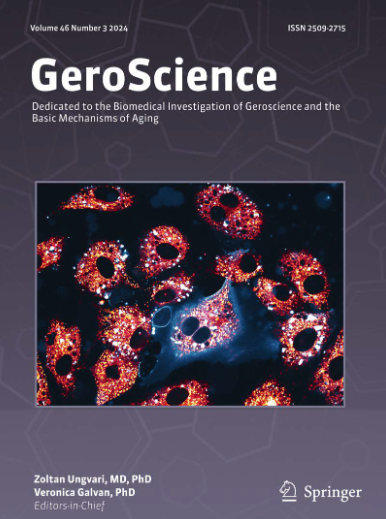Serum ACE2 activity as a novel biomarker of assessment of severe aortic stenosis.
IF 5.3
2区 医学
Q1 GERIATRICS & GERONTOLOGY
引用次数: 0
Abstract
Aortic stenosis (AS) is the most prevalent valve disease in developed countries, with its incidence rising in the aging population. The current criteria for aortic valve replacement (AVR) are based on subjective symptoms and left ventricular ejection fraction (LVEF), which may not adequately reflect left ventricular (LV) dysfunction. This highlights the necessity for objective biomarkers to evaluate subclinical LV dysfunction. Serum angiotensin-converting enzyme 2 (sACE2) has emerged as a promising novel biomarker for cardiovascular diseases. To investigate the association between sACE2 activity and different flow-grade categories of severe AS, compare it with the traditional biomarker N-terminal pro-brain natriuretic peptide (NT-proBNP), and assess the utility of sACE2 as a biomarker for AS. sACE2 and NT-proBNP were measured in 175 patients (97 male, 78 female, mean age 75 ± 8 years) diagnosed with severe AS (aortic valve area, AVA ≤ 1 cm2). Patients were classified into 5 groups depending on LV flow state and pressure gradient levels: normal flow-low gradient (NF-LG), normal flow-high gradient (NF-HG), low flow-high gradient (LF-HG), low flow-low gradient (LF-LG), and paradoxical low flow-low gradient (PLF-LG) AS. Both biomarkers showed a general increase with advanced stages of severe AS (NF-LG: 65.0 ± 3.5 U/ml; LF-LG: 148.1 ± 16.8 U/ml; P < 0.05 for sACE2 and NF-LG: 687 ± 193 pg/ml; LF-LG: 5966 ± 1076 pg/ml; P < 0.05 for NT-proBNP). Notably, PLF-LG patients exhibited NT-proBNP levels similar to NF groups (PLF-LG: 1010 ± 218 pg/ml). Both biomarkers negatively correlated with LVEF and AVA. Receiver operating characteristic (ROC) analysis revealed that sACE2 provides incremental value over NT-proBNP in detecting subclinical LV dysfunction, with a 44% specificity for sACE2 compared to 6% for NT-proBNP at 98,67% sensitivity. The assessment of sACE2 activity in patients with AS provides valuable insights into disease stage and progression, supporting clinical decision-making and optimizing the timing of AVR. Furthermore, sACE2 activity serves as a moderately sensitive blood biomarker for identifying patients at risk of AS.血清ACE2活性作为评估严重主动脉狭窄的新生物标志物。
主动脉瓣狭窄(Aortic stenosis, AS)是发达国家最常见的瓣膜疾病,其发病率随着人口老龄化而上升。目前主动脉瓣置换术(AVR)的标准是基于主观症状和左室射血分数(LVEF),这可能不能充分反映左室(LV)功能障碍。这突出了客观生物标志物评估亚临床左室功能障碍的必要性。血清血管紧张素转换酶2 (sACE2)已成为一种有前景的新型心血管疾病生物标志物。为了研究sACE2活性与不同血流等级类别严重AS之间的关系,将其与传统的生物标志物n端前脑利钠肽(NT-proBNP)进行比较,并评估sACE2作为AS生物标志物的实用性。对175例确诊为重度AS(主动脉瓣面积,AVA≤1 cm2)患者(男97例,女78例,平均年龄75±8岁)进行sACE2和NT-proBNP检测。根据左室血流状态和压力梯度水平将患者分为5组:正常流量-低梯度(NF-LG)、正常流量-高梯度(NF-HG)、低流量-高梯度(LF-HG)、低流量-低梯度(LF-LG)和矛盾低流量-低梯度(PLF-LG) AS。两种生物标志物均随严重AS晚期普遍升高(NF-LG: 65.0±3.5 U/ml;LF-LG: 148.1±16.8 U/ml;sACE2、NF-LG: 687±193 pg/ml, P < 0.05;LF-LG: 5966±1076 pg/ml;NT-proBNP P < 0.05)。值得注意的是,PLF-LG患者的NT-proBNP水平与NF组相似(PLF-LG: 1010±218 pg/ml)。这两种生物标志物与LVEF和AVA呈负相关。受试者工作特征(ROC)分析显示,在检测亚临床左室功能障碍方面,sACE2比NT-proBNP具有更高的价值,sACE2的特异性为44%,而NT-proBNP为6%,敏感性为98.67%。对AS患者sACE2活性的评估为疾病分期和进展提供了有价值的见解,支持临床决策和优化AVR的时机。此外,sACE2活性可作为一种中等敏感的血液生物标志物,用于识别有as风险的患者。
本文章由计算机程序翻译,如有差异,请以英文原文为准。
求助全文
约1分钟内获得全文
求助全文
来源期刊

GeroScience
Medicine-Complementary and Alternative Medicine
CiteScore
10.50
自引率
5.40%
发文量
182
期刊介绍:
GeroScience is a bi-monthly, international, peer-reviewed journal that publishes articles related to research in the biology of aging and research on biomedical applications that impact aging. The scope of articles to be considered include evolutionary biology, biophysics, genetics, genomics, proteomics, molecular biology, cell biology, biochemistry, endocrinology, immunology, physiology, pharmacology, neuroscience, and psychology.
 求助内容:
求助内容: 应助结果提醒方式:
应助结果提醒方式:


